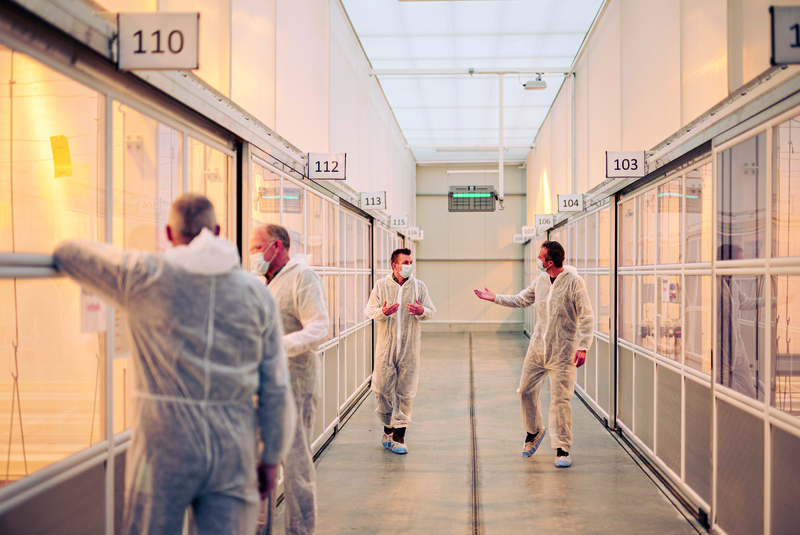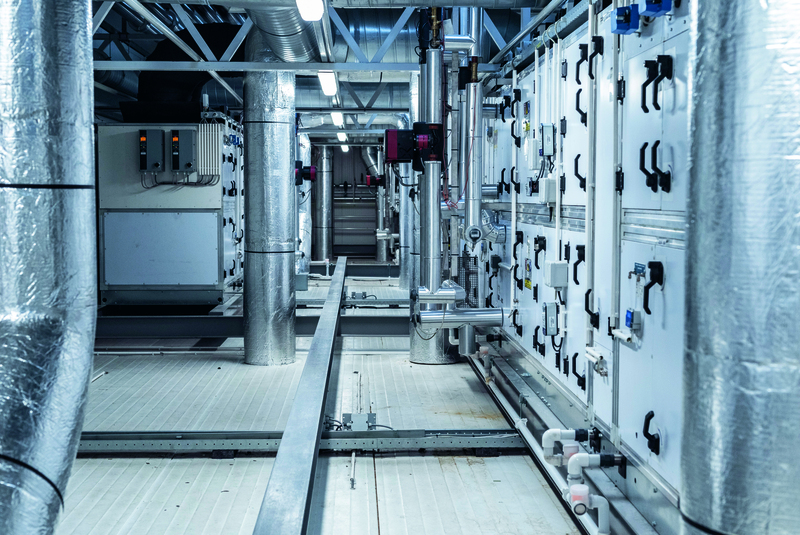
Bram Klein, Peter Jansen (AAB.nl), Herjan Bak en Peter Couwels
Koppert aims to make a significant contribution to sustainability, reducing CO2 emissions and ensuring more efficient energy and water consumption. In line with this goal, the construction of the new ‘insect factory’ in Berkel en Rodenrijs fully supports the company’s mission and vision. ‘We want to rear sustainable products in a sustainable environment,’ says Peter Maes, Corporate Marketing Director. ‘We’re part of the environment and food cycle. Without taking a critical look at yourself, you won’t do what needs to be done.’
The construction of Koppert’s new production site is nearing completion. The first phase was launched at the beginning of 2019, and the second phase has recently been completed. A lot of preparation went into the project, as Peter Maes explains: ‘We had lots of sessions and discussions at Koppert. It was an intensive process involving a huge number of new developments with Koppert employees and various contractors working in close synergy. We had a joint vision: to create a company that was fit for the future. All elements of our new production location are founded on our “Partners with Nature” mission.’
Koppert has three different production arms: pollinators (Natupol), fungi, bacteria, and nematodes (micro), and insects and mites (macro). Macrobials are an important arm, explains Business Unit Manager Peter Couwels: ‘At macro, we’re growing by more than 10% per year thanks to catalysts such as consumer food safety, sustainability, cultivation intensity, and legislation and regulations. We support this ongoing growth by ensuring extra breeding capacity and making better use of the available capacity by increasing our efficiency per square metre. With more stable production outputs, our customers can enjoy a higher service level in terms of supply security and quality.’

Long preparation process
The design process for the new production location began in 2016. Koppert’s old location was expropriated for urban expansion for the city of Rotterdam, after which a plot of grassland near Berkel en Rodenrijs was purchased for the construction of a three-hectare, state-of-the-art greenhouse. Koppert worked together with consultancy firm AAB NL to design the location and coordinate construction activities. In addition to sales support, AAB NL took care of the purchase of the location and the permit application process. Following a year and a half of preparations, the construction of the production site began in 2018.
‘The preparation phase was a key opportunity to lay down all the requirements of the Koppert teams and incorporate them in the design,’ says AAB NL consultant Peter Jansen. ‘Which type of greenhouse is most suitable for rearing insects and for Koppert’s wishes and requirements? How large should the departments be and how should the layout and logistics routing be designed? What is needed to rear insects and what central facilities are required for this purpose?’ Jansen names some of the considerations.
The design of the production site, which is eligible for a Green Label Greenhouse Certification, focused on three major elements: sustainability, quality, and innovation and technology. Preliminary energy studies were performed to assess the design’s sustainability, Jansen explains. On the basis of analyses, the decision was made to install heat pumps centrally in order to meet the requirements for cooled air. ‘Cooled air is generated sustainably by heat pumps,’ he adds. ‘This cooled air is transferred to the rearing units. The resulting low-grade heat is transferred to the greenhouses and halls, and will soon also be transferred to the office building.’ This same principle has been applied to the units, where thermal wheels recover 80% of energy.
That Koppert’s approach to greenhouse rearing and production is anything but ordinary is reflected in the complexity of the water system. There are several types of water circuits – fertilized water, rainwater, osmosis, and tap water – with each mesh cage having its own tap group (sometimes several groups). The water that is used to clean the cages is collected separately and recycled. Koppert is also a member of the Rainlevelr programme of the Delfland Water Authority. As part of this programme, based on voluntary participation, Delfland informs growers about the rainfall forecast and notifies them when more buffer capacity is needed. Growers then free up capacity in their rainwater silos before a forecast of heavy showers. This cooperation prevents the water system from becoming overwhelmed, in turn reducing the risk of flooding and water damage.

‘Insect-tight’ greenhouse
Another important element in the new building is quality, which is something Koppert is keen to offer its customers, according to Bram Klein, Project Manager at Koppert. ‘The greenhouse’s complexity is reflected in the large number of departments – twenty of them in total. Each department can be controlled separately and can function autonomously in terms of climate, irrigation, and lighting. But the greenhouse must also be completely “insect-tight”. We have several rearing lines, with insects reared in batches. As we want to prevent contamination between different departments at all times, we spent a lot of time in cooperation with various parties and suppliers investigating ways to hermetically seal the batches. Our joint quest for tailored solutions produced various test set-ups, which resulted in a solution that you won’t find anywhere else in the world.’
In addition, flexible insect cages have been developed for the R&D Department, which is now able to divide one large space into several smaller ones. Hygiene is crucial in all aspects of the greenhouse, including how the departments are physically separated from one other. ‘This is very far-reaching: almost all technical aspects of the greenhouse are placed outside the cultivation departments or can be accessed by the maintenance department via a service room,’ says the Project Manager.

Specific wishes
As the plans were being turned into reality, the quality-related demands revealed their own set of challenges. This called on contractors’ and system fitters’ ability to think and work differently in order to achieve Koppert’s desired quality level, explains Koppert’s construction supervisor Herjan Bak: ‘This isn’t a standard greenhouse – it’s a complex project. Some aspects, such as how to ensure the greenhouse was “insect-tight”, were tricky at first and led to a lot of discussions. Gradually, however, contractors became more proactive and produce their own ideas. Many constructions and solutions have been designed specifically for Koppert in cooperation with its suppliers’.
This quality standard is also evident in maintenance and safety, explains Bak: ‘We have a maintenance vehicle, and each department has feed-through ports. As each component also has a label and code, and wiring and piping have flow arrows, we’ve made maintenance easier. The entire location is also equipped with an automatic fire alarm system and has an escape route. Operational safety really has been a major focus.’
Alongside the cutting-edge quality aspects, a whole set of innovations and technologies have been incorporated on the production site. A few examples are multilayer cultivation systems using energy-efficient LED fixtures, sealing caps for emergency power supplies, Wi-Fi coverage across the entire site for scanning purposes (tracking & tracing), and a special hygiene area for cleaning and disinfecting materials. As each department can be controlled separately, optimal conditions can be created for each rearing phase. This translates directly into the quality of the products according to Bram Klein.
Building lasting relationships
As mentioned above, Koppert worked closely with contractors and system fitters during the design and construction phase for the new production site. Koppert is eager to establish long-term relationships, says Corporate Marketing Director Peter Maes: ‘We build a network with each other and explore new ways of creating synergies. Koppert now works with a number of regular contractors and system fitters on-site. They are always fully briefed and know what’s expected of them.’
One of Koppert’s partners is KUBO Greenhouse Projects: ‘Koppert and KUBO have been working together for some years now,’ says Wouter Kuiper, Director of KUBO. ‘Both companies are family businesses and now in their third generation. The fact that we’re still partners shows how committed we are to working together in the long term. The project we took on for Koppert was higher-level greenhouse construction. Any challenge you can think of, it’s in there. And we make a success out of these challenges.’
Peter Maes concludes by emphasizing the value of teamwork: ‘You need each other and can learn from each other. By working as a partnership, you can contribute to each other’s goals. This approach has resulted in a unique, future-proof production location for Koppert.’
This article is written by KAS Magazine
Text: Annemarie Gerbrandy
Photography: Linda Straathof